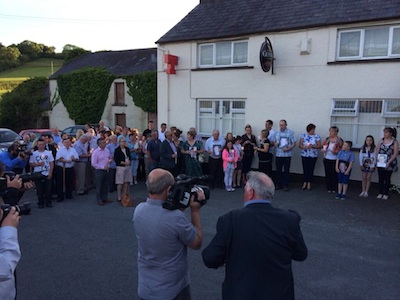
The families and friends of those killed in the Loughinisand massacre gathered at the County Down village this week to remember the 20th anniversary of those killed on June 18 1994.
The six men killed were Adrian Rogan, Patrick O’Hare, Eamon Byrne, who were in their thirties, Malcolm Jenkinson and Daniel McCreanor, both in their fifties, and 87-year-old Barney Greene. They died after a UVF gang burst into the Heights Bar and began shooting indiscriminately during a World Cup game between Ireland and Italy.
No-one has ever been convicted for the attack. On Wednesday, a memorial Mass to mark the 20th anniversary of the atrocity was followed by a candlelit procession to the Heights bar.
Some relatives of those who died spoke about their pain 20 years on. One woman who lost her husband said: “This year is particularly hard.”
Earlier this month, the Police Ombudsman notified the PSNI that he is to take legal action over the force’s refusal to provide information on more than 100 occasions, stalling investigations into the Heights Bar attack and some 60 other deaths.
Aidan O’Toole, the barman who survived the attack, said he still grieves for those killed.
“I remember that night like it was yesterday and with the World Cup on this year, the mood and feelings are particularly poignant,” he said. “I survived that night but my thoughts are with those that didn’t. There’s not a day that goes past that I don’t think about them and their families.
“We’ll not stop until we get to the truth as to why Loughinisland was allowed to happen and why there was nobody ever brought to court. The only time we are in a court these days is when we are trying to get the police to tell the truth. Why can’t they let us know what happened?”
A lawyer for the families, Niall Murphy of KRW law, described a fresh appeal by the PSNI for witnesses to come forward as “an insult to the families’ intelligence”.
“The fact is that there was an over-whelming response from the public about this case,” he said. “All of the key exhibits in this case were found by the public not the police. Within hours, the getaway car was found by member of the public but far from retaining it for forensic purposes the police destroyed it within months.
“Members of the public also found the guns, the balaclavas, the boiler suits and the gloves, but far from securing forensic evidence from the suspects arrested, police refused to take DNA and fingerprints from nine of 16 people arrested.
“So, far from securing and preserving evidence, police have been refusing the gather evidence and when they did, in the case of the car, they destroyed the evidence”.
In 2011 a report by the then police ombudsman found that a female witness who came forward in 2009 had her details handed to the relative of a suspect by a serving police officer. A former senior officer who worked on the case has also refused to cooperate with the ombudsman.
Mr Murphy said that any further appeal for co-operation should be directed at the police themselves.
“This is a case, where we have the incredible position that the Ombudsman has had to take High Court Judicial Review proceedings to gain access to intelligence that he is entitled to inspect,” he added.
Clare Rogan, whose husband Adrian was one of those murdered, said that two decades on, her pain continues. “All anniversaries are difficult to deal with, however this year is particularly hard,” she said.
“It is hard to believe 20 years have passed. What is more difficult to believe is that the police are still refusing to cooperate with the Police Ombudsman after all these years. What has the chief constable got to hide? Who are the police trying to protect after all this time?”
![[Irish Republican News]](https://republican-news.org/graphics/title_gifs/rn.gif)
![[Irish Republican News]](https://republican-news.org/graphics/title_gifs/harp.gif)

